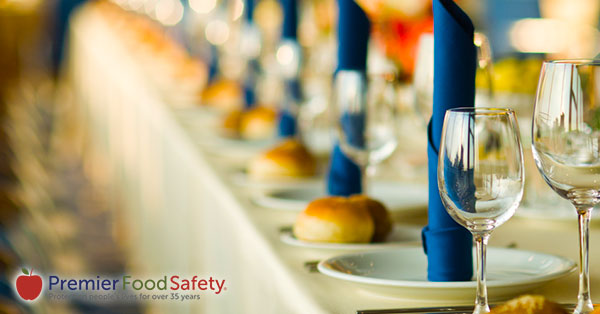Published October 27, 2015
Coffee culture sure has come a long way in America since the time when it was thought of as a bottomless-refill commodity. The beverage is now a signature item for many restaurants that brings in traffic and drives profit. Coffee continues to be an innovative menu sector, as shown by Starbucks’ recent introduction of cold-brewed coffee and Chik-fil-a’s partnership with the sustainable coffee supplier THRIVE. Novel coffee preparations like fizzy nitrogen coffee and the fat-laden Bulletproof Coffee are also reaching new levels of popularity.
With coffee being such a strong beverage player, it makes sense that chefs are now incorporating more coffee into foods both savory and sweet. Coffee adds intriguing notes of bitterness to savory dishes like celeriac pasta at Chicago’s Tete Charcuterie and braised oxtail at Boston’s Fairsted Kitchen. Chefs have found that coffee can complement many other ingredients like red meat, pork, chili peppers, beets, and duck. Coffee is also a classic dessert ingredient, and chefs are serving up everything from classic tiramisu to chicory-flavored Vietnamese coffee ice cream. With coffee so hot right now, it might be the perfect time to think about putting it on your food menu.
Read the full article here: Coffee’s Influence Expands to Savory, Sweet Foods
Published October 27, 2015
Drinking glass manufacturer SymGLASS has released a new line of unbreakable drinkware called PubWARE. The new glasses are made of a proprietary polymer that looks and feels like real glass while being completely unbreakable. Better yet, they don’t scratch up like other plastic unbreakable cups and they insulate and frost up better than glass. PubWARE cups come in pint and tulip styles that are perfect for craft beer, and industry pricing is available for pubs and restaurants.
Read the full article here: PubWARE Releases New Unbreakable Craft Beer Mugs
Published October 26, 2015
Did you know that the average American eats over 15 pounds of pasta a year? While that’s nothing compared to the 51 pounds Italians eat, it’s still a lot of noodles. An article from Restaurant Hospitality has some tips for putting new spins on this classic favorite in honor of National Pasta Month. Chef Lou Piuggi recommends serving pasta with seasonal accompaniments, while Adam Sappington of the Countyr Cat amps up the richness with a crispy fried egg.
Read the full article here: Build a Better: Next-Gen Pasta Dish
Published October 26, 2015
 The weather is turning colder, the leaves are off the trees, and Halloween decorations are everywhere: it’s the holiday season. That means that we’re entering the busiest and most profitable time of the year for catering services. FSR Magazine has a great piece about how to pull off holiday catering without losing your money or your mind. The big takeaways are that you should know what you can realistically provide, let people know what your services are, and not take on huge jobs just because they are profitable.
The weather is turning colder, the leaves are off the trees, and Halloween decorations are everywhere: it’s the holiday season. That means that we’re entering the busiest and most profitable time of the year for catering services. FSR Magazine has a great piece about how to pull off holiday catering without losing your money or your mind. The big takeaways are that you should know what you can realistically provide, let people know what your services are, and not take on huge jobs just because they are profitable.
Before getting into catering, you should ask yourself what services you can provide and figure out what your capabilities and costs are. Research what sorts of food travel and hold well, and train staff to be knowledgable about the food and polite and helpful with clients. Don’t take enormous jobs with a high payout that you know you don’t actually have the capacity to do. Many restaurants make the mistake of jumping from catering 50-person events to catering 500-person galas, and provide poor service as a result. Customer satisfaction is paramount, as we all know how important good Yelp reviews are. Most importantly, anyone who wants to start catering should calculate their costs down to the penny before advertising to clients.
With these tips in mind, you should be prepared to tackle the holiday catering rush and come home with a present for yourself too!
Read the full article here: 3 Tips to Get a Catering Division Running by the Holidays
Published October 26, 2015
More than 95 percent of Americans love barbecue, and all kinds of restaurants are reaping the benefits. Smoky meat and tangy sauce have always been popular at barbecue-centric restaurants, and now customer demand has driven over half of all restaurants to offer some sort of barbecue menu item. One of the pioneers of expanding barbecue into the quick service market was McDonald’s, whose McRib special item has driven customer loyalty and excitement since its introduction in the 1980s. Other brands like Subway and Wendy’s have since jumped into the barbecue market.
Read the full article here: Barbecue’s Wide Appeal: Retail and Restaurant Trends
Published October 23, 2015
Eater recently came out with a great feature about Wall Drug Store, the roadside throwback that serve’s America’s cheapest cup of coffee. Wall Drug is a blast from the past whose billboards blanket South Dakota’s I-90 highway trumpeting 5-cent coffee, free ice water, and old-fashioned donuts. The article also uses Wall as a jumping-off point for a discussion of how far coffee has come in America.
It can be hard to remember in these Starbucks-obsessed times, but there was a time when most American coffee was low-quality and flavorless. Coffee consumption was actually decreasing before successful chains like Starbucks and Peet’s spread strong coffee and cafe culture throughout America.
The U.S. is now in its ‘third wave’ of coffee culture, with innovative baristas and roasters expanding public knowledge about fancy coffee-brewing techniques and the ethical ramifications of coffee-sourcing. Americans certainly have many more choices when they decide to buy a cup of joe than they did 50 years ago when Wall first started selling coffee for a nickel. It’s nice to have a reminder of what coffee was like in simpler times.
Read the full article here: America’s Cheapest Cup of Coffee
Link: http://www.eater.com/drinks/2015/10/21/9578183/americas-cheapest-coffee
Published October 23, 2015
In a recent panel discussion at the Fast Casual Executive Summit in Miami, three design experts talked about the importance of design for wooing millennial customers. One of the panelists, Nick DiCarlo, the director of restaurant solutions for Wendy’s, gave concrete examples of how revamping the chain’s decor drove customer interest and got great feedback. The experts also mentioned specific design trends that are popular with consumers at the moment, like open kitchens, fewer walls, and a strong sense of identity.
Read the full article here: FCES15: Why Design is Key to Customer Service
Link: http://www.fastcasual.com/articles/fces15-why-design-is-key-to-customer-engagement/
Published October 23, 2015
By the time customers finish their entrees, they often don’t have much room to eat dessert, or they don’t want a boatload of extra calories. That may be why a majority of restaurant customers say they prefer to share desserts when eating out. Operators can capitalize on these preferences by offering desserts that are intended to be shared. Whether it’s an assortment of miniature cupcakes or one enormous cookie, a shareable dessert can convince customers to splurge.
Read the full article here: Shareable Desserts Sweeten Sales
Link: http://nrn.com/sponsored-content/shareable-desserts-sweeten-sales
Published October 22, 2015
The Affordable Care Act has been changing the way small business owners run their operations, and restaurants are no different. The ACA mandates that all businesses with more than 100 workers provide healthcare for employees who work more than 30 hours a week. Soon, businesses who employ more than 50 people will have to provide healthcare as well. This new expense will cut into restaurants’ already thin margins, and operators are looking for ways to stay solvent.
The obvious solution is to raise prices. However, just rolling all extra costs into food prices may make restaurants seem overpriced and convince customers to stay home. The Rustic Canyon restaurant group in Santa Monica, California has a different idea. Instead of simply raising prices, Rustic Canyon implemented a 3 percent healthcare surcharge on checks at all of its restaurants. The group does this so it won’t be unfairly accused of overpricing their food, and also so customers know more about what expenses the money they pay are covering.
Rustic Canyon says the program is going well, and while some people raised a fuss initially most customers happily pay the fee. However, most of the customer base of the group’s restaurants are neighborhood regulars, and it is unclear if more touristy restaurants will have a hard time convincing customers to pay extra for employee healthcare.
Read the full article here: Are Surcharges the Solution to Pay for Healthcare?
Link: https://www.fsrmagazine.com/human-resources/are-surcharges-solution-pay-healthcare
Published October 22, 2015
New data shows shat 25 percent of Americans are interested in trying unconventional and international cuisine. Over 90 percent of Americans have tried international favorites like Italian, Chinese, and Mexican food, and more exotic offerings like Ethiopian, Korean, and Brazilian food are growing in popularity. When eating international dishes, most Americans prefer to be at restaurants, indicating that they want professionals to guide them through the experience of trying new and unfamiliar dishes.
Read the full article here: American Diners Have an Appetite for Ethnic Cuisine
Link: http://smartblogs.com/food-and-beverage/2015/10/21/american-diners-have-an-appetite-for-ethnic-cuisine/

 The weather is turning colder, the leaves are off the trees, and Halloween decorations are everywhere: it’s the holiday season. That means that we’re entering the busiest and most profitable time of the year for catering services. FSR Magazine has a great piece about how to pull off holiday catering without losing your money or your mind. The big takeaways are that you should know what you can realistically provide, let people know what your services are, and not take on huge jobs just because they are profitable.
The weather is turning colder, the leaves are off the trees, and Halloween decorations are everywhere: it’s the holiday season. That means that we’re entering the busiest and most profitable time of the year for catering services. FSR Magazine has a great piece about how to pull off holiday catering without losing your money or your mind. The big takeaways are that you should know what you can realistically provide, let people know what your services are, and not take on huge jobs just because they are profitable.

Coffee Craze Continues into Food
Coffee culture sure has come a long way in America since the time when it was thought of as a bottomless-refill commodity. The beverage is now a signature item for many restaurants that brings in traffic and drives profit. Coffee continues to be an innovative menu sector, as shown by Starbucks’ recent introduction of cold-brewed coffee and Chik-fil-a’s partnership with the sustainable coffee supplier THRIVE. Novel coffee preparations like fizzy nitrogen coffee and the fat-laden Bulletproof Coffee are also reaching new levels of popularity.
With coffee being such a strong beverage player, it makes sense that chefs are now incorporating more coffee into foods both savory and sweet. Coffee adds intriguing notes of bitterness to savory dishes like celeriac pasta at Chicago’s Tete Charcuterie and braised oxtail at Boston’s Fairsted Kitchen. Chefs have found that coffee can complement many other ingredients like red meat, pork, chili peppers, beets, and duck. Coffee is also a classic dessert ingredient, and chefs are serving up everything from classic tiramisu to chicory-flavored Vietnamese coffee ice cream. With coffee so hot right now, it might be the perfect time to think about putting it on your food menu.
Read the full article here: Coffee’s Influence Expands to Savory, Sweet Foods
Commentary
Comments closed